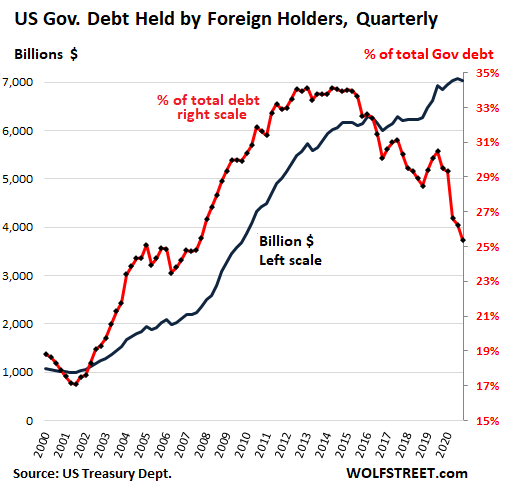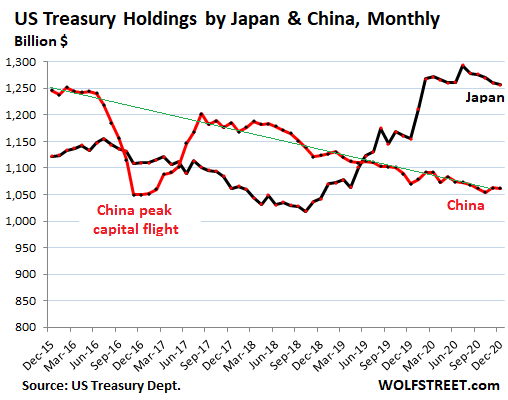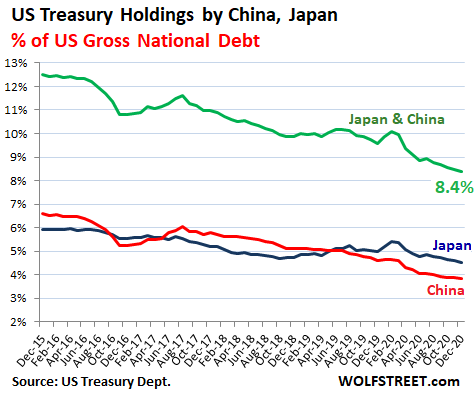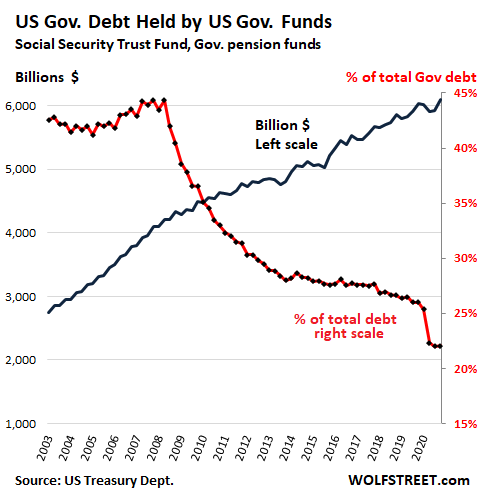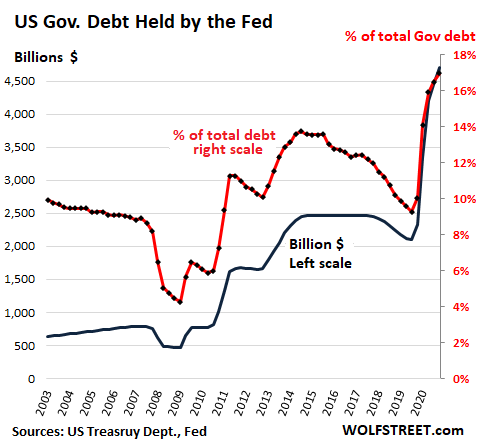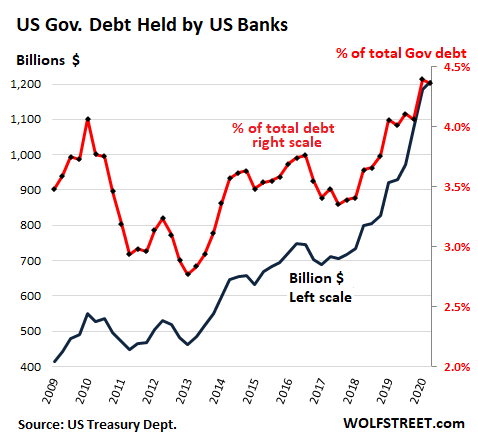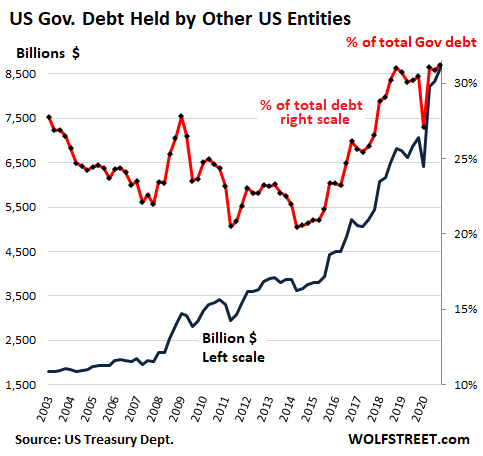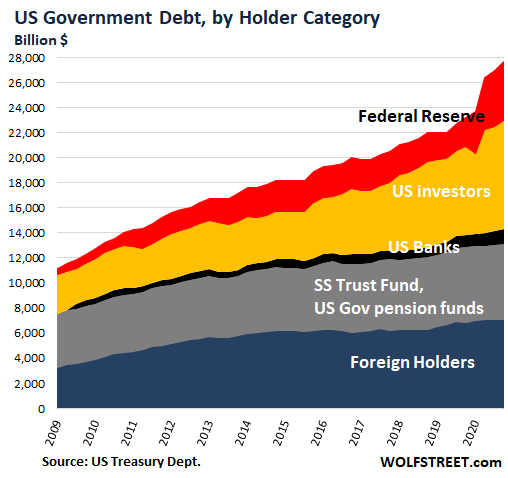Who Bought the $4.5 Trillion Added in One Year to the Incredibly Spiking US National Debt, Now at $27.9 Trillion?
ANGLO AMERICA, 22 Feb 2021
Wolf Richter | Wolf Street - TRANSCEND Media Service
Someone had to buy every dollar of this monstrous debt. Here’s Who. The Fed isn’t the only one. But China continues to unwind its holdings.
17 Feb 2021 – Driven by stimulus and bailouts, and fired up by the tax cuts and by grease and pork, the Incredibly Spiking US National Debt has skyrocketed by $4.55 trillion in 12 months, to $27.86 trillion, after having already spiked by $1.4 trillion in the prior 12 months, which had been the Good Times. These trillions are all Treasury Securities that form the US national debt, and someone had to buy every single one of these securities: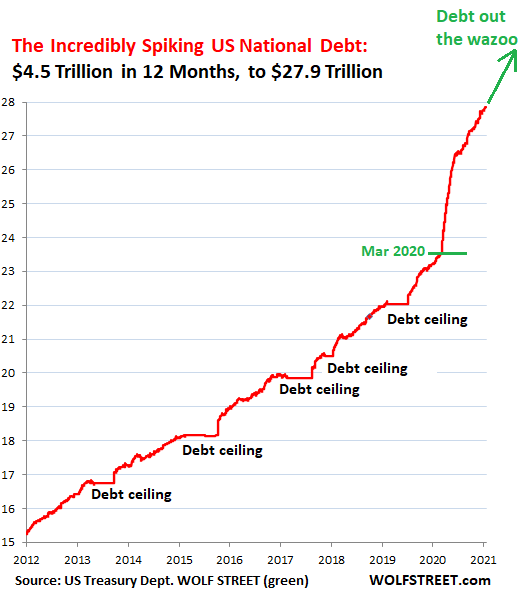
So we’ll piece together who bought those trillions of dollars in Treasury Securities that have whooshed by over the past 12 months.
Tuesday afternoon, the Treasury Department released the Treasury International Capital data through December 31 which shows the foreign holders of the US debt. From the Fed’s balance sheet, we can see what the Fed bought. From the Federal Reserve Board of Governors bank balance-sheet data, we can see what the banks bought. And from the Treasury Department’s data on Treasury securities, we can see what US government entities bought.
Share of Foreign Holders Falls to 25% for First Time since 2007:
In the fourth quarter, foreign central banks, foreign government entities, and foreign private-sector entities such as companies, banks, bond funds, and individuals, reduced their holdings by $35 billion from the third quarter, to $7.04 trillion. This was still up from a year ago by $192 billion (blue line, right scale in the chart below). But their share of the Incredibly Spiking US National Debt fell to 25.4%, the lowest since 2007 (red line, right scale):
Japan (blue line), the largest foreign creditor of the US, reduced its holdings in Q4 by $20 billion, to $1.26 trillion. But compared to a year earlier, its holdings were still up by $102 billion.
China (red line) continued on trend, gradually reducing its holdings. In Q4, its holdings ticked down just a tad, and over the 12-month period fell by $8 billion, to $1.06 trillion:
Japan’s and China’s relative importance in the Incredibly Spiking US National Debt continues to decline, with their combined total ($2.32 trillion) now down to a share of 8.4%, the lowest in years:
The Next 10 biggest foreign holders in December include tax havens and financial centers where US corporations have legal entities that hold US Treasuries, such as Ireland. So some of these “foreign” holders are US cash-rich corporations, such as Apple, with Treasuries that are registered in their foreign mailbox entities.
But Mexico and Germany, with which the US has the second and third largest goods trade deficits (behind China) are in 24th and 20th place respectively and didn’t make this list. The amounts in parenthesis show holdings of 12 months ago:
- UK (“City of London” financial center): $447 billion ($392 billion)
- Ireland: $315 billion ($281 billion)
- Luxembourg: $275 billion ($254 billion)
- Brazil: $259 billion ($281 billion)
- Switzerland: $255 billion ($237 billion)
- Belgium: $247 billion ($207 billion)
- Hong Kong: $230 billion ($250 billion)
- Taiwan: $229 billion ($193 billion)
- India: $210 billion ($162 billion)
- Cayman Islands: $200 billion ($238 billion)
US Government Funds Add Treasuries but Their Share Declines Further, Outrun by the Incredibly Spiking US National Debt
The US Social Security Trust Fund, pension funds for federal civilian employees, pension funds for the US military, and other federal government funds added $178 billion in Q4 compared to Q3 and $74 billion over the 12-month period, to their holdings, now amounting to record of $6.1 trillion (blue line, left scale). But the share of the Incredibly Spiking US National Debt, at 22% same as in Q3, was the lowest in eons, and was down from 45% in 2008 (red line, right scale):
Federal Reserve Monetization of the US Debt
The Fed added $253 billion to its Treasury holdings in Q4, bringing the pile to $4.7 trillion by the end of December (blue line, left scale), a record share of 17.5% of the Incredibly Spiking US National Debt (red line, right scale). Over the 12-month period, the Fed added $2.37 trillion in Treasuries to its holdings, more than doubling its pile:
US Banks Stock Up on Treasuries
US commercial banks added $24 billion in Treasury securities in Q4 to their holdings, and $277 billion over the 12 months, bringing the total to a record $1.21 trillion, according to the Federal Reserve’s data release on bank balance sheets. They now hold 4.4% of the Incredibly Spiking US National Debt:
Other U.S. Entities & Individuals
After all foreign-registered holders, the Fed, US government funds, and US banks are accounted for, the remaining Treasuries are by definition held by US individuals and institutions. These include bond funds, pension funds, insurers, US corporations, hedge funds that use Treasuries in complex leveraged trades, private equity firms that need to park their cash, etc.
Holdings of these US entities surged by $332 in Q4 and by $1.58 trillion in the 12-month period to a record $8.65 trillion (blue line, left scale), for a share of the Incredibly Spiking US National Debt of 31.2% (red line, right scale), making them the largest holder of that monstrous mountain of debt:
The Monstrous Mountain of Debt by Segments
All these holders of the monstrous US Treasury debt, combined into one mountain, and color-coded for your amusement by category of holder as of December 31:
Go to Original – wolfstreet.com
Tags: Anglo America, China, Debt, Economic Crisis, Economics, Economy, USA, War Economy
DISCLAIMER: The statements, views and opinions expressed in pieces republished here are solely those of the authors and do not necessarily represent those of TMS. In accordance with title 17 U.S.C. section 107, this material is distributed without profit to those who have expressed a prior interest in receiving the included information for research and educational purposes. TMS has no affiliation whatsoever with the originator of this article nor is TMS endorsed or sponsored by the originator. “GO TO ORIGINAL” links are provided as a convenience to our readers and allow for verification of authenticity. However, as originating pages are often updated by their originating host sites, the versions posted may not match the versions our readers view when clicking the “GO TO ORIGINAL” links. This site contains copyrighted material the use of which has not always been specifically authorized by the copyright owner. We are making such material available in our efforts to advance understanding of environmental, political, human rights, economic, democracy, scientific, and social justice issues, etc. We believe this constitutes a ‘fair use’ of any such copyrighted material as provided for in section 107 of the US Copyright Law. In accordance with Title 17 U.S.C. Section 107, the material on this site is distributed without profit to those who have expressed a prior interest in receiving the included information for research and educational purposes. For more information go to: http://www.law.cornell.edu/uscode/17/107.shtml. If you wish to use copyrighted material from this site for purposes of your own that go beyond ‘fair use’, you must obtain permission from the copyright owner.
